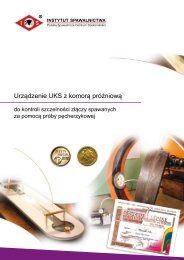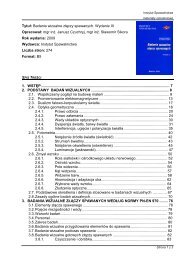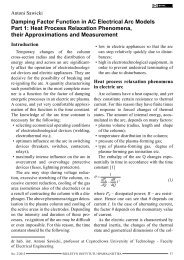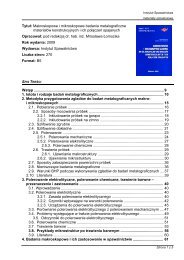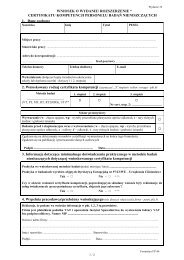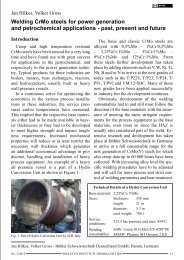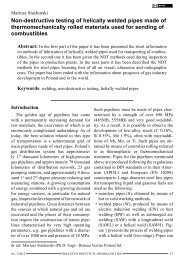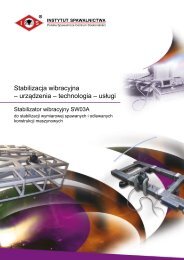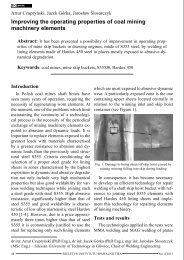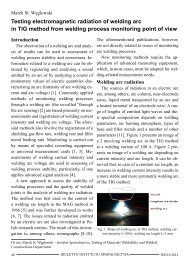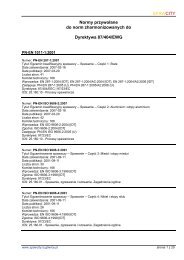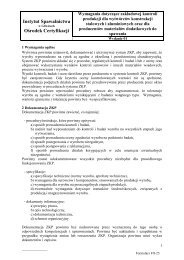Biuletyn Instytutu Spawalnictwa No. 01/2012
Biuletyn Instytutu Spawalnictwa No. 01/2012
Biuletyn Instytutu Spawalnictwa No. 01/2012
Create successful ePaper yourself
Turn your PDF publications into a flip-book with our unique Google optimized e-Paper software.
Other, equally important research is focused<br />
on plasma. Methods applied in the plasma-related<br />
investigation are those of emission spectroscopy<br />
and laser radiation scattering (laser<br />
spectroscopy). The aforesaid methods make it<br />
possible to calculate such plasma parameters<br />
as the temperature and concentration of atoms<br />
(ions, electrons) [37].<br />
Emission spectroscopy is a passive method,<br />
in which electromagnetic radiation originating<br />
from plasma (one or many spectral lines) is<br />
registered and analysed. The main advantage<br />
of this method is the simplicity of carrying out<br />
measurements. The method requires an optical<br />
focusing system, monochromator or spectrometer<br />
and detector (e.g. a photomultiplier or<br />
CCD matrix). The major disadvantage is the<br />
fact that radiation being registered is total radiation<br />
emitted from plasma. In order to obtain<br />
measurement data from one specific measurement<br />
point it is necessary carry out the Abel<br />
transformation [38]. Another disadvantage is<br />
the necessity to assume that plasma is in a state<br />
of local thermodynamic equilibrium and is<br />
optically thin.<br />
Laser spectroscopy is a more universal method,<br />
yet it requires the source of laser radiation<br />
and a detection system. The method of laser<br />
spectroscopy enables the determination of<br />
plasma parameters in a given point. In some<br />
cases, laser spectroscopy makes it possible to<br />
calculate plasma parameters without assuming<br />
that plasma is in thermodynamic equilibrium.<br />
The technique utilises the Rayleigh scattering,<br />
Tomson scattering, laser-induced fluorescence<br />
and diphoton laser-induced fluorescence [37].<br />
Plasma radiation registered in measurements<br />
perpendicularly to the discharge axis is a sum of<br />
contributions from various layers (Fig. 4). The<br />
so-called Abel transform [37, 38] makes it possible<br />
to determine ε(x) on the basis of known I(x).<br />
Fig. 4. Sectional view of plasma column, discharge axis is<br />
perpendicular to paper sheet plane: A- radial distribution<br />
of emission factor, B – side view of intensity distribution.<br />
I(x) – distribution of radiation intensity in plane perpendicular<br />
to direction, in which plasma is observed, x – distance<br />
from direction of plasma observation [38]<br />
When plasma is characterised by cylindrical<br />
symmetry in the sectional view under observation<br />
and the phenomenon of self-absorption is<br />
not present, the distribution of radiation intensity<br />
in the plane perpendicular to the direction<br />
of plasma observation is expressed by the following<br />
formula [38]:<br />
r0<br />
ε<br />
( )<br />
() r ⋅ r<br />
I x = 2⋅<br />
∫ dr<br />
2 2<br />
x r − x<br />
(8)<br />
where: ε(r) – intensity of radiation emitted<br />
by plasma on the unit of thickness of a layer<br />
distant from the discharge axis by r, x – distance<br />
from the direction of plasma observation<br />
(Fig. 4), 2r 0<br />
– diameter of an area where plasma<br />
is present.<br />
The so-far research into welding arc plasma<br />
aimed, among others, at the creation of<br />
a mathematical-physical model of an arc [39,<br />
40] which could be useful in designing new<br />
welding devices [41]. Also important, from<br />
the practical point of view, is research aiming<br />
to determine the impact of electrical parame-<br />
NR <strong>01</strong>/2<strong>01</strong>2<br />
BIULETYN INSTYTUTU SPAWALNICTWA<br />
45



